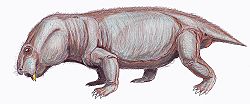| Gordonia Temporal range: Late Permian | |
|---|---|
 | |
| Cast of the holotype skeleton of Gordonia traquairi | |
| Scientific classification | |
| Domain: | Eukaryota |
| Kingdom: | Animalia |
| Phylum: | Chordata |
| Clade: | Synapsida |
| Clade: | Therapsida |
| Suborder: | † Anomodontia |
| Clade: | † Dicynodontia |
| Infraorder: | † Dicynodontoidea |
| Genus: | † Gordonia Newton, 1893 |
| Type species | |
| †G. traquairi Newton, 1893 | |
| Synonyms | |
| |
Gordonia is an extinct genus of dicynodont therapsid from the Late Permian of Scotland. Fossils have been found from the Elgin sandstone of Cutties Hillock Sandstone in Elgin, Moray. These are among the many amniote fossils referred to as the Elgin Reptiles. Gordonia was named in 1893 with four species: G. traquairi, G. duffiana, G. huxleyana, and G. juddiana. Currently, the only recognized species is the type G. traquairi. All other species are considered synonyms of the type.







